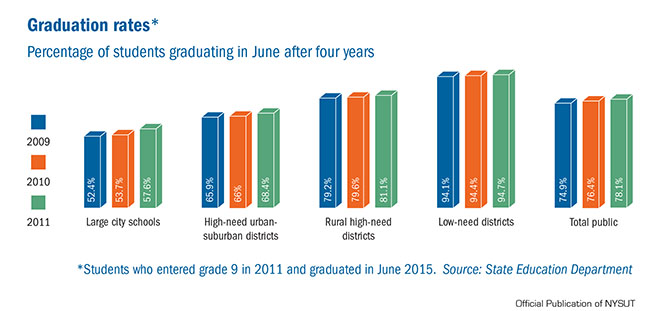High school graduation rates for 2014–15 reflect steady progress, but they also show the achievement gap remains unacceptable for the state's neediest students.
The statewide graduation rate for students who entered grade 9 in 2011 was 78.1 percent, up 1.7 percentage points. That's the good news. The bad news, highlighted in State Education Department data presented to the Regents in January, shows a number of achievement gaps remain:
- 68.4 percent of students in high-need schools graduated in four years, compared to more than 94 percent of students from low-need districts;
- While 88 percent of white students graduated in four years, 65.5 percent of black and Hispanic students graduated on time;
- Special education students need more attention: Only about 50 percent of students with disabilities graduated in four years.
NYSUT Vice President Catalina Fortino said the results make it clear that a greater state investment is needed to close the achievement gaps.
The Regents must move forward with plans to create more pathways to graduation by expanding options, she said.
Lifting graduation rates in the state's large high-need school districts, where more than half of students live in poverty, will take a significant new investment in smaller class sizes; academic support programs; additional guidance counselors and social workers; and programs to support newly arrived students, English language learners and students with special needs, Fortino said.
Additional state funding, especially for small city, rural and the Big Five school districts, is essential.
"We know that when we provide additional support for access and opportunity to students in high-need districts, they graduate and contribute to the success of our communities and our country," Fortino said.
As part of the discussion on how to improve graduation rates, the Regents reviewed three proposals for expanding graduation pathways for all students. These include allowing students to appeal scores within five points of passing on up to two Regents exams; approving project-based assessments as a pathway to graduation; and adding Career Development and Occupational Studies (CDOS) for all students.
The Regents recently approved five other pathways for students: Science, Technology, Engineering and Math (STEM), Mathematics, Arts, Bi-Literacy (LOTE) and Career and Technical Education (CTE). These multiple pathways are known as "4+1," meaning students must pass four required Regents Exams (math, English, science and social studies) and an equally rigorous alternative assessment in their selected discipline instead of a fifth Regents exam.
NYSUT will address details of these new proposals in the coming months with SED and the Regents.